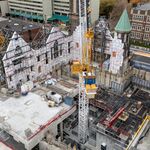k10ery
Senior Member
The TR makes the NY Times: http://www.nytimes.com/2013/10/21/n...-cars-mta-may-consider-new-model.html?hp&_r=0
Please paste the article here; I had reached my limit for the paywall.The TR makes the NY Times: http://www.nytimes.com/2013/10/21/n...-cars-mta-may-consider-new-model.html?hp&_r=0
Please paste the article here; I had reached my limit for the paywall.
You can clear your cookies to bypass the paywall (it works for the Star and G & M), which resets the limit. Also, some browsers allow you to block cookies from a specific website.
A Subway Car With Fewer Doors, but More Ways Out
For decades, the New York City subway car has been a predictable space. Some have seats; some have benches. Graspable pole options vary only slightly. Mariachi bands play, and self-appointed preachers preach.
And if there is no seat, no room, no end to a performance, there is often no escape for a rider — at least until the next stop.
That may yet change. Metropolitan Transportation Authority officials are envisioning a subway car of the future that offers New Yorkers an out, ending the era of the captive car population.
This month, in a 142-page document outlining needs for the next 20 years, the authority noted the benefits of articulated trains — similar to accordion-style buses — that have no doors between cars, allowing unrestricted flow throughout the length of the subway.
“This will both maximize carrying capacity,†the authority said, and allow passengers to “move to less-crowded areas of the train, balancing loading and unloading times at all doors.â€
The inclusion of articulated train cars in the report, a mild surprise to some transit advocates, does not guarantee that the cars will reach the rails anytime soon, or even at all; it was not clear how the cost of the articulated cars compares with that of nonarticulated cars. But for the first time in the subway system’s modern history, the authority appears poised to seriously consider a model adopted in cities like Berlin, Paris and Toronto.
Adam Lisberg, the authority’s chief spokesman, said that increased capacity could improve “dwell time†— the period during which a train is stopped in a station, often because of overcrowding — and allow more trains to run. He cautioned, though, that with a 109-year-old system, any major change required extensive review.
“If you make a bad call on changing equipment in a new subway car order,†he said, “the consequences can be pretty serious.â€
In fact, New York City has a history with articulated trains. In 1924, the Brooklyn-Manhattan Transit Corporation introduced plans for the “Triplex,†with a hinged, multisectioned body. It operated on the B, D, N, Q and R lines over a period of 40 years, representing “the height of transit modernity†at a moment when elevated lines often still featured wooden cars, according to the New York Transit Museum.
Today, many of the city’s subway cars are well past their prime, most strikingly those on the C line, known by their model number, R32, and for the tin-can siding that will continue rolling beneath Eighth Avenue for at least a few more years.
Though newer models now on the tracks are expected to last 30 to 40 more years, transit planners have urged the authority to consider articulated trains for any future fleet upgrades.
“We’re one of the largest systems in the world that doesn’t do it,†said Richard Barone, the director of transportation programs at the Regional Plan Association. “Our trains don’t function right now to allow people to circulate.â€
Elsewhere, the trains have proved largely successful. Brad Ross, a spokesman for the Toronto Transit Commission, which began using an “open gangway†model two years ago, said capacity had increased by 8 percent to 10 percent.
In the model’s early months, Mr. Ross said, passengers would often let trains with traditional cars pass them by, preferring the features — or at least the novelty — of the new ones.
But there have been pitfalls. Mr. Ross said that young children have been disappointed that the conductor cab occupies the entire width of a car, precluding the pastime of peering into the tunnel from a front window. “An amusement ride no more,†he said.
Then there is the scourge of the sick passenger, most ominously on weekends or holidays like New Year’s Eve, Mr. Ross said, when evidence of overindulgence can occasionally find its way onto a car’s floor.
“In the past, we’d be able to isolate that particular car and clean it,†he said. “Now that you’ve got an open gangway, you can’t necessarily.â€
Andrew Albert, a member of the transportation authority’s board, recalled that separated cars had served another purpose for the city in a different age.
“Remember the time when we were in the high-crime era and gangs were roaming through the trains?†he said. “Everybody loved the locked end doors.â€
But passengers now seem receptive to the idea of articulated trains. In areas where a rider’s choice of car is significant — like a southbound No. 1 train, which allows only those in the first five cars to exit at South Ferry — a new model would provide far more flexibility, pre-empting the typical platform sprint to the front of the train.
Denise Reyes, 28, from the Bronx, said the doors had been used most memorably in movies, in which characters have been known to shove through them during climactic chase scenes. As a consequence, she said, any open subway door can be startling.
“The city is stressful,†Ms. Reyes said, boarding a No. 1 train at 23rd Street. “You don’t need more stress.â€
Elizabeth Kubany, 44, who works in the Flatiron district, expressed a fondness for the current configuration, suggesting that the separated cars were more “intimate,†binding passenger to passenger in an increasingly antisocial age. Then she reconsidered.
“You don’t really want to be intimate ith people on the train,†she said.
What's their route from the BBD plant in Thunder Bay? Thanks.
East bound on Highway 7 in Havelock Ontario yesterday.




